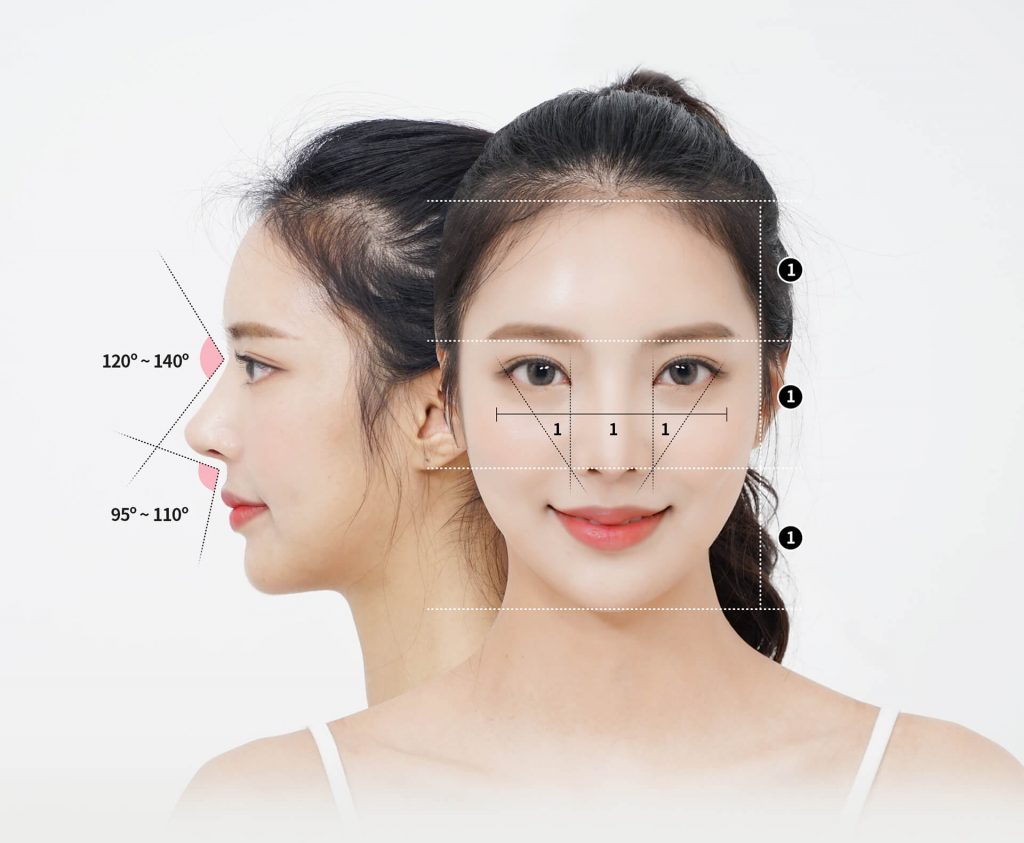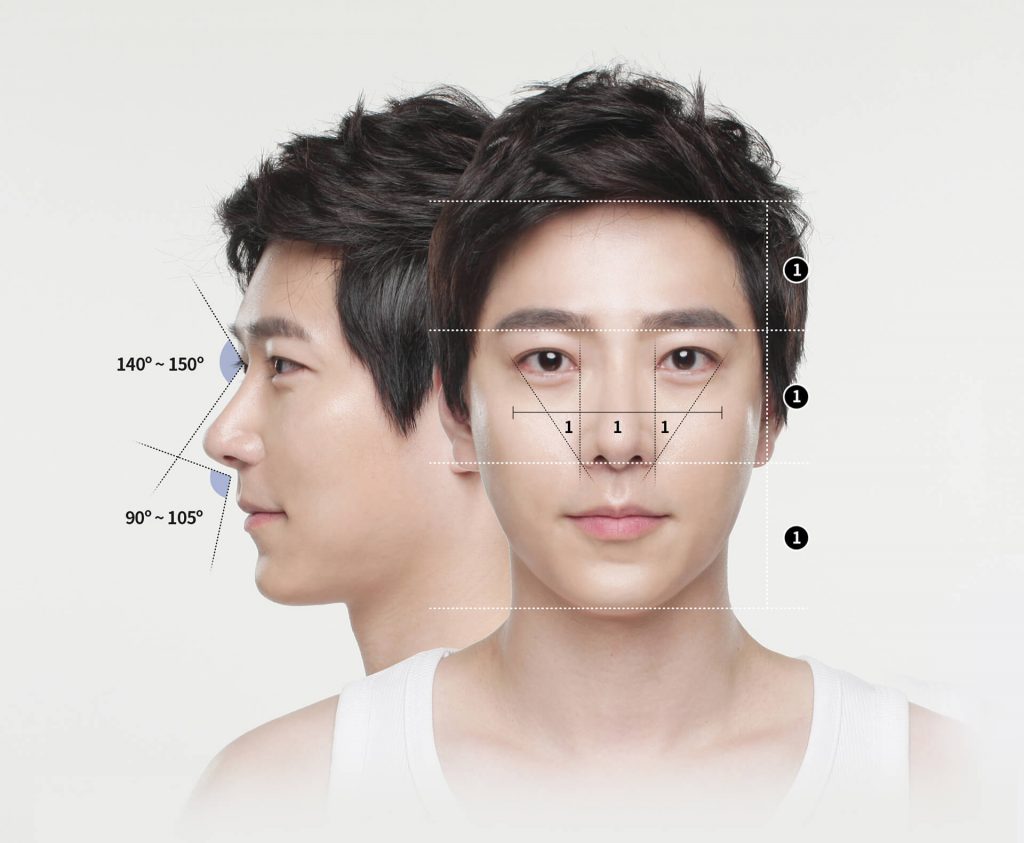Having a well-proportioned face is an important part of looking and feeling attractive. But having a wide and stubby nose can draw unnecessary attention to your face, and make your facial proportions unbalanced.
So if you are looking to narrow your broad nose, wide nose surgery is the best solution to your problem. Read along to find out more about the surgery, its procedure, benefits and risks.
What is the golden ratio for Korean noses?
The golden ratio varies among individuals because everyone is born with different nose shapes, features and face shape. The key to a beautiful nose is finding the balance between your eyes, nose and face shape.
Here is a rough guide for finding the optimal ratio for your nose:

Optimal nose ratio for women:
- Ideal ratio between the forehead-eyebrows, eyebrows-nose, and nose-chin is 1:1:1.
- Optimal ratio between the length of eyes and width of nose is 1:1:1.
- Inner corner of eyes and corner of nose should be vertically aligned.
- Outer corner of eyes and corner of nose should be diagonally aligned.
- Width of nose bridge should be 70~80% of the width of nostrils.
- Ideal angle for the “sunken” area at the top of nose (nasofrontal angle) is 120°~140°.
- Optimal angle between the nose and upper lip (nasolabial angle) is 95°-110°.
- Having a supratip break (subtle indentation just above nose tip) is considered attractive for a woman’s nose.
- Slightly curved nose bridges makes women look more feminine.

Optimal nose ratio for men:
- Ideal ratio between the forehead-eyebrows, eyebrows-nose, and nose-chin is 1:1:1.
- Optimal ratio between the length of eyes and width of nose is 1:1:1.
- Inner corner of eyes should be vertically aligned with corner of nose.
- Outer corner of eyes should be diagonally aligned with corner of nose.
- Width of nose bridge should be 70~80% of the width of nostrils.
- Ideal angle for the “sunken” area at the top of nose (nasofrontal angle) is 140°~150°.
- Optimal angle between the nose and upper lip (nasolabial angle) is 90°-105°.
- Straight nose bridges makes men look more masculine.
What is wide nose surgery?
Wide nose surgery, aka lateral osteotomy, is a rhinoplasty procedure targeted to slim down a wide nose bridge. It involves breaking the bone structure at the top of the nose into smaller pieces and moving it closer together to narrow down the nose bridge.
Lateral osteotomy surgery is suitable for those who have:
- Tall but wide nose bridges
- Thick nose bridges which makes their nose look stubby
- Flat and broad nasal bridges
More often than never, patients with wide nose bridges also have a flat and broad nasal tip (nostrils). In such cases, tipplasty (rhinoplasty for a more defined nose tip) or alarplasty (rhinoplasty to reduce the width of nostrils) is performed together to achieve an overall appearance of a slimmer and defined nose.
Benefits of wide nose surgery
Slimming down a wide nose creates balance and harmony of your nose and other facial features. Other benefits of wide nose surgery include:
- Slimmer nose bridge
- Nose bridge appears to be higher
- Appearance of a sharper nose
- Facial harmony of nose and other facial features
That said, do not get a nose bridge that is too narrow because it can in turn, cause nasal breathing difficulties.
Wide nose surgery methods
There are 2 methods used for wide nose surgery – open method and closed method. The open method is of course, the most preferred by nose surgeons, as it allows for accurate reshaping of your nose.
1. Open rhinoplasty
The open approach involves a cut across your columella (the narrow strip of skin separating your nostrils). This method allows the surgeon full access to your nose, and enables for major or complex reshaping. Hence, a high chance of achieving your desired results.
Benefits:
- Allows for complex reshaping of your nose
- Minimize chances of nasal cartilage distortion
- Enables complex reshaping of nose bridge
- Produces more accurate and precise results
- Natural looking results
Downsides:
- Minimal scarring (but scars fade over time)
2. Closed rhinoplasty
The closed approach involves incisions inside your nose, so there’s no obvious scarring. However, this method limits the surgeon’s access of your nose. Hence, major or complex reshaping is not possible. Suitable for only minor work.
Benefits:
- Non-visible scarring
- Shorter recovery time
- Natural looking results
Downsides:
- Does not allow for major or complex reshaping of nose
- Risk of inaccurate results
- Mostly used for minor work only
How long does wide nose surgery take?
Wide nose surgery in Korea usually lasts 20~30 mins and is performed under sedation anesthesia.
When can I see results?
Major swelling and bruising for rhinoplasty lasts up to 1 week but accurate results are visible after 1 month. Final results are seen after 1 year. For at least 1 month, take extra care not to knock or exert pressure on your nose bridge. In addition, you will need to wear an external nose splint on your nose (for about 7 days) to support the shape of your new nose.
Do take note that the success of your wide nose surgery not only lies in the hands of your surgeon but also how you well you recover after surgery. So learn how to properly care for yourself during the recovery period by reading our article on nose surgery aftercare and post-op instructions.
Actual recovery time vary among individuals, and is subjected to one’s health condition & healing response.
How long should I stay in Korea?
Wide nose surgery in Korea is not considered a major surgery so hospitalization is not required. But do stay until your stitches are removed. And go shopping in the meantime!
Stitch removal
Stitches are usually removed 7 days after surgery.
Cautions on stitch removal
If you remove the stitches earlier then advised, your wound might reopen, therefore causing an infection. And if you remove it too late, you risk further scarring and pigmentation.
Don’t rush the recovery procedure for best results!
Due to time constraints, you might be considering having your stitches removed at the local hospitals in your home country. Although that is possible (but not recommended), it largely depends on how well you have been healing and is also subjected to doctor’s approval.
Alternatives to wide nose surgery
Unfortunately, there isn’t any alternatives to treat a wide nose except for undergoing wide nose surgery. Getting nose fillers to increase the height of your nose bridge might give the illusion of a thinner nose bridge, but if your nasal bridge base is too wide, it would make your nose appear bigger instead.
What other surgery complements wide nose surgery?
1. Alarplasty
If you have wide nostrils, alarplasty is combined with wide nose surgery to achieve an overall appearance of a slimmer nose.
2. Tip plasty surgery
If you have a flat nose tip, tip plasty is combined with wide nose surgery to achieve an overall appearance of a sharp and defined nose.
3. Flat nose surgery
For those who have a flat and wide nose, you might want to consider flat nose surgery for a higher and sharper nose.
4. Septoplasty surgery
If you have a crooked nose, even if it’s not for aesthetic reasons, get it fixed for functional reasons with septoplasty.
Conclusion
Having a wide and stubby nose makes your nose the center of attraction of your face, but not for a good reason. Hence, wide nose surgery is a good option to reshape your nose without the use of implants.
In addition, if your nose bridge is not too flat, it will even appear to be higher after getting this surgery. However, be careful not to overdo it because an overly thin nose bridge can result in breathing difficulties.
Above all, make sure to consult a professional doctor who is highly skilled and well-versed in nose surgeries for the best results, of course.
cosmetic surgery in koreakorean nose jobkorean rhinoplastynose job in koreaplastic surgery in korearhinoplasty in korea









What do you think?